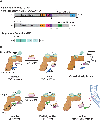A cellular atlas of calcineurin signaling
- PMID: 36191737
- PMCID: PMC9948804
- DOI: 10.1016/j.bbamcr.2022.119366
A cellular atlas of calcineurin signaling
Abstract
Intracellular Ca2+ signals are temporally controlled and spatially restricted. Signaling occurs adjacent to sites of Ca2+ entry and/or release, where Ca2+-dependent effectors and their substrates co-localize to form signaling microdomains. Here we review signaling by calcineurin, the Ca2+/calmodulin regulated protein phosphatase and target of immunosuppressant drugs, Cyclosporin A and FK506. Although well known for its activation of the adaptive immune response via NFAT dephosphorylation, systematic mapping of human calcineurin substrates and regulators reveals unexpected roles for this versatile phosphatase throughout the cell. We discuss calcineurin function, with an emphasis on where signaling occurs and mechanisms that target calcineurin and its substrates to signaling microdomains, especially binding of cognate short linear peptide motifs (SLiMs). Calcineurin is ubiquitously expressed and regulates events at the plasma membrane, other intracellular membranes, mitochondria, the nuclear pore complex and centrosomes/cilia. Based on our expanding knowledge of localized CN actions, we describe a cellular atlas of Ca2+/calcineurin signaling.
Keywords: Calcineurin; Calcium; Phosphatase; Phosphorylation; SLiMs; Signaling.
Copyright © 2022 Elsevier B.V. All rights reserved.
Conflict of interest statement
Declaration of competing interest The authors declare that they have no known competing financial interests or personal relationships that could have appeared to influence the work reported in this paper.
Figures


Similar articles
-
Identifying New Substrates and Functions for an Old Enzyme: Calcineurin.Cold Spring Harb Perspect Biol. 2020 Mar 2;12(3):a035436. doi: 10.1101/cshperspect.a035436. Cold Spring Harb Perspect Biol. 2020. PMID: 31308145 Free PMC article. Review.
-
Interaction of calcineurin with substrates and targeting proteins.Trends Cell Biol. 2011 Feb;21(2):91-103. doi: 10.1016/j.tcb.2010.09.011. Epub 2010 Nov 4. Trends Cell Biol. 2011. PMID: 21115349 Free PMC article. Review.
-
Identification of small-molecule inhibitors of calcineurin-NFATc signaling that mimic the PxIxIT motif of calcineurin binding partners.Sci Signal. 2015 Jun 23;8(382):ra63. doi: 10.1126/scisignal.2005918. Sci Signal. 2015. PMID: 26106221
-
Protein kinase CK2-dependent phosphorylation of the human Regulators of Calcineurin reveals a novel mechanism regulating the calcineurin-NFATc signaling pathway.Biochim Biophys Acta. 2013 Oct;1833(10):2311-21. doi: 10.1016/j.bbamcr.2013.05.021. Epub 2013 Jun 1. Biochim Biophys Acta. 2013. PMID: 23732701
-
Inhibition of calcineurin-NFAT signaling by the pyrazolopyrimidine compound NCI3.Eur J Immunol. 2007 Sep;37(9):2617-26. doi: 10.1002/eji.200737087. Eur J Immunol. 2007. PMID: 17694572
Cited by
-
Calcineurin contributes to RNAi-mediated transgene silencing and small interfering RNA production in the human fungal pathogen Cryptococcus neoformans.bioRxiv [Preprint]. 2024 Jan 13:2023.07.25.550548. doi: 10.1101/2023.07.25.550548. bioRxiv. 2024. Update in: Genetics. 2024 Mar 6;226(3):iyae010. doi: 10.1093/genetics/iyae010. PMID: 37546757 Free PMC article. Updated. Preprint.
-
Evolving Strategies for Use of Phytochemicals in Prevention and Long-Term Management of Cardiovascular Diseases (CVD).Int J Mol Sci. 2024 Jun 4;25(11):6176. doi: 10.3390/ijms25116176. Int J Mol Sci. 2024. PMID: 38892364 Free PMC article. Review.
-
Calcineurin B inhibits calcium oxalate crystallization, growth and aggregation via its high calcium-affinity property.Comput Struct Biotechnol J. 2023 Jul 31;21:3854-3864. doi: 10.1016/j.csbj.2023.07.038. eCollection 2023. Comput Struct Biotechnol J. 2023. PMID: 37593722 Free PMC article.
-
Calcineurin controls the cytokinesis machinery during thermal stress in Cryptococcus deneoformans.Proc Natl Acad Sci U S A. 2025 May 27;122(21):e2503751122. doi: 10.1073/pnas.2503751122. Epub 2025 May 21. Proc Natl Acad Sci U S A. 2025. PMID: 40397671 Free PMC article.
-
Calcineurin-dependent contributions to fitness in the opportunistic pathogen Candida glabrata.mSphere. 2024 Jan 30;9(1):e0055423. doi: 10.1128/msphere.00554-23. Epub 2024 Jan 3. mSphere. 2024. PMID: 38171022 Free PMC article.
References
Publication types
MeSH terms
Substances
Grants and funding
LinkOut - more resources
Full Text Sources
Miscellaneous

